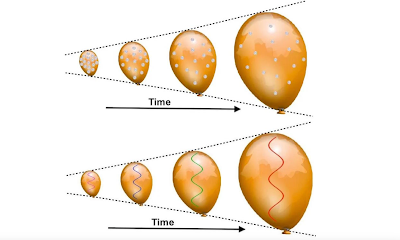"From a region of space as small as can be imagined (all the way down to the Planck scale), cosmological inflation causes space to expand exponentially: relentlessly doubling and doubling again with each tiny fraction-of-a-second that elapses. Although this empties the Universe and stretches it flat, it also contains quantum fluctuations superimposed atop it: fluctuations that will later provide the seeds for cosmic structure within our own Universe. What happened before the final ~10^-32 seconds of inflation, including the question of whether inflation arose from a singular state before it, not only isn't known, but may be fundamentally unknowable." (BigThink, Ask Ethan: What’s the deal with cosmic inflation and the Big Bang?)
The universe requires cosmic inflation. Cosmic inflation releases energy. That was once bound to material and black holes. So, we can say that cosmic inflation keeps the energy moving.
The key element of modern cosmology is that the Big Bang released all energy and material into its entirety. We call that entirety "the universe". All particles bound energy from space. Or they roll wave movement to the ball-shaped structure. The free energy is the thing that makes reactions in the universe possible. When energy takes particle form it is bound to the structure.
The interaction between the particle and its environment determines the length of the particle's existence. If the particle's energy level is very high. Energy travels fast to its environment. And that destroys the particle.
The idea of cosmic inflation is simple. If the space expands. But if there are no more particles or energy from outside the space expands if we compare it with material and energy. So there is more space in comparison to particles.
When the universe expands its energy level turns lower. That means the energy always travels out from the material. Or, particles release energy that they bound a long time ago in their structure.
The expansion of the universe causes the amount of matter and energy relative to space to decrease. The universe is like a balloon in a vacuum. When energy and material travel out from the Universe that makes it lighter.
"As a balloon inflates, any coins glued to its surface will appear to recede away from one another, with “more distant” coins receding more rapidly than the less distant ones. Any light will redshift, as its wavelength ‘stretches’ to longer values as the balloon’s fabric expands. This visualization solidly explains cosmological redshift within the context of the expanding Universe. If the Universe is expanding today, that implies a past where it was smaller, hotter, denser, and more uniform: leading to the picture of the hot Big Bang." (BigThink, Ask Ethan: What’s the deal with cosmic inflation and the Big Bang?)
The universe loses its energy and material into the space around it. Material is one form of energy. Particles are packed wave movement that we call energy. Sometimes that is called outer border inflation. There is also one other inflation. When black holes pull energy inside them, that means energy that travels to black holes is out from the universe and its interactions. So the black holes cause an effect that we can call inner inflation.
When things like atoms form in big stars. That means the star creates a fusion that combines light atoms into a new element. When elementary particles form in the young universe they bound energy into their structures. When the Schwinger effect or wave-particle duality forms elementary particles it rolls wave movement into the ball-shaped structures. That wave movement or energy was away from the energy interaction. There was limited energy in the universe. Because all energy existed in the universe, that meant that there couldn't be an unlimited number of elementary particles.
If energy or or wave movement would be like water we might simply say that there is a smaller energy mass and smaller number of particles in the modern universe than in the young universe. Some of those particles flew away from the universe and turned back into wave movement. Some of them are in black holes.
They release black when those black holes vaporize. Black holes take energy and material in them. And that means there is a lower number of particles and a lower free energy level in the universe. Cosmic inflation causes a thing that we can call quantum vaporization.
Because the energy level in the universe decreases all the time energy travels out from material or particles all the time. This thing means that cosmic inflation causes material vaporization where it turns back. To energy or wave movement. Black holes are also vaporizing. The black hole sends energy waves all the time into the universe.
When the universe expands black holes are losing energy. The expansion causes the material disk around the black hole to jump outside. That means there can form a small energy vacuum between a black hole and its material disk. That effect rips energy out from the layer that is at the front of the event horizon.
The material disk around the black hole is the thing that pumps energy into the black hole. If a black hole travels to the cosmic vacuum energy starts to travel out from it.
https://bigthink.com/starts-with-a-bang/ask-ethan-cosmic-inflation-big-bang/







No comments:
Post a Comment
Note: Only a member of this blog may post a comment.